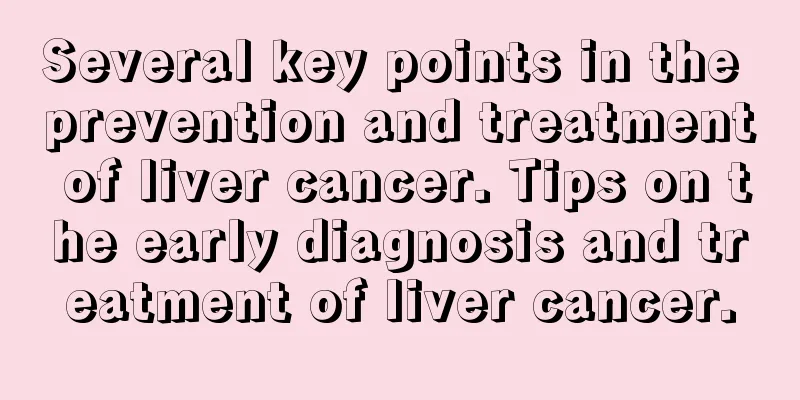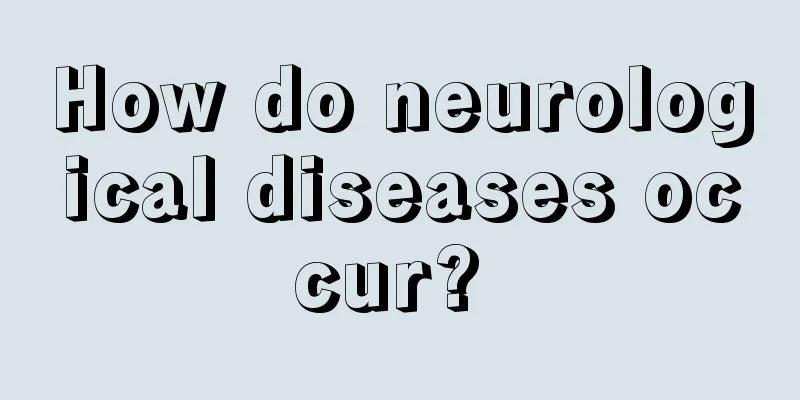Several key points in the prevention and treatment of liver cancer. Tips on the early diagnosis and treatment of liver cancer.

|
Taking health supplements to nourish the liver? Extended treatment may cause cancer Hepatitis B and C are prevalent in Taiwan. The general public works day and night and is worried about "liver failure". They mistakenly think that liver protection can be achieved by taking health food such as liver protection tablets, which often delays treatment. As a result, the hepatitis virus causes liver fibrosis and hardening, and even worsens into liver cancer. The biggest culprit of liver cancer is hepatitis B, followed by hepatitis C. According to clinical statistics, about 10% of liver cancer patients are chronically infected with hepatitis C, and the proportion in central and southern Taiwan can be as high as 50%, which is shocking! Eating health food without treatment may cause liver fibrosis, hardening and liver cancer Eating liver-protecting health foods of unknown origin cannot block the replication of the hepatitis virus and damage the liver. The hidden danger is that if you take health foods for a long time without seeking formal treatment, although there will be no obvious abnormalities in the short term, it will be a great burden on the liver. Many hepatitis patients end up on dialysis, which is also related to this. The liver will also gradually become fibrotic and hardened, and even greatly increase the risk of liver cancer. There are 600,000 people with hepatitis C in Taiwan, which is mainly transmitted through blood. Therefore, as long as there is a chance of blood contact, people who have received blood transfusions, used unclean needles, tattooed, acupunctured, or pierced ear instruments that are not completely disinfected, shared toothbrushes or razors, or drug addicts share needles and diluents, etc., may be infected with hepatitis C. Unlike hepatitis B virus, the rate of hepatitis C virus transmission through sexual behavior and mother-to-child vertical transmission is quite low; in addition, there is currently no hepatitis C vaccine to prevent it. Hepatitis C virus can be said to be another liver killer second only to hepatitis B virus. Half of liver cancer patients in central and southern China are hepatitis C patients Clinically, about half of liver cancer patients in central and southern Taiwan are hepatitis C patients, and some towns even have clusters of cases. In addition to sharing unclean needles in the early stage, improper medical behavior is also one of the reasons behind this. Combining treatment for different genotypes of hepatitis C offers a glimmer of hope Dr. Chen Zongmiao said that there are different genotypes of hepatitis C, which can be divided into at least 6 major genotypes and more than 50 minor genotypes, and they are slightly different in different parts of the world. Currently, the treatment of chronic hepatitis C is covered by medical insurance in Taiwan. The course of treatment is to inject long-acting interferon once a week, and then take the oral drug Ribavirin for 24 to 48 weeks. Clinical trial results show that for the common hepatitis C type 1 and type 2, the complete cure rate of the former is 70% to 80%, and the latter is as high as more than 90%. After half a year of treatment, the virus level is completely undetectable. For hepatitis C patients, life has a glimmer of hope! Hepatitis C treatment drug side effects can be improved with the help of drugs The treatment of hepatitis C is changing with each passing day, but there are still many patients who give up treatment for fear of side effects. For example, they are overly afraid of possible side effects after treatment. Through word of mouth, they mistake the fatigue, nausea, insomnia, hair loss and other side effects of interferon as chemotherapy, or they worry that rebavirin may cause hemolytic anemia. In fact, side effects vary from person to person, not everyone will experience them. Even if side effects occur, the symptoms are mostly mild and can be improved with the help of drugs. Patients should not give up treatment for fear of choking and miss the opportunity for treatment, or even the chance of cure. The prevention and treatment of hepatitis C is urgent and we must start with source management Prevention and treatment of hepatitis C is urgent! Dr. Chen Zongmiao said that it is necessary to manage the source first, find where the hepatitis C patients are, prevent them from infecting others, and encourage them to receive treatment. Now that drugs are advancing rapidly, there is not only a new dawn of treatment, but also a chance of cure. In addition, patients need to be tracked regularly to observe whether they have active hepatitis, and undergo liver cancer screening, and do blood and ultrasound tests every six months. Tumor experts talk about new progress in liver cancer prevention and treatment - prevention of causes, early diagnosis, standardized diagnosis and treatment Prevention and treatment of liver cancer is the most important 1. Control viral hepatitis Hepatitis viruses are currently the main cause of liver cancer, mainly including hepatitis B and hepatitis C. The inflammatory response caused by hepatitis viruses leads to progressive damage to liver cells, which leads to the occurrence of liver cancer through the carcinogenic effect of viral DNA and the carcinogenic effect of inflammatory response. Studies have shown that more than 90% of liver cancer patients in my country have a history of viral hepatitis. Universal vaccination of newborns with hepatitis B vaccine can effectively control the spread of hepatitis B. In areas with a high incidence of liver cancer in my country, a significant decline in the incidence of liver cancer in adolescents has been observed, and it is expected that hepatitis B-related liver cancer in my country will decline significantly in the future. Antiviral treatment for hepatitis B virus can fully inhibit the virus and reduce the damage of the virus to the liver, thus blocking the occurrence of cirrhosis and reducing the carcinogenic effect of inflammatory factors. It can effectively block the occurrence of cirrhosis, thereby reducing the risk of liver cancer. In addition, hepatitis patients should have a regular life and avoid excessive fatigue to prevent a decrease in immunity and aggravation of liver function damage. There is no vaccine to prevent hepatitis C, so it is very important to block the spread of hepatitis C virus and reduce the chance of contracting hepatitis C. Hepatitis C is mainly transmitted through improper injections, so avoiding the reuse of injection needles can significantly reduce the spread of hepatitis C. For patients who have already developed hepatitis C, antiviral treatment should also be actively carried out to reduce the occurrence of cirrhosis. 2. Actively treat fatty liver In recent years, the relationship between fatty liver and liver cancer has received attention. Long-term fatty liver can lead to cirrhosis, which increases the risk of liver cancer. Studies have shown that in economically developed societies, the risk of liver cancer in patients with fatty liver is second only to the risk of liver cancer caused by hepatitis C. Diabetes, hyperlipidemia, drinking, and obesity are the main factors causing fatty liver. In today's society, the number of people suffering from obesity, diabetes, and hyperlipidemia is rapidly increasing, which is the main reason for the increase in the incidence of fatty liver. It has been reported that the incidence of fatty liver in obese and diabetic patients reaches 50%, and some patients may develop cirrhosis. Improper lifestyle is also a risk factor for fatty liver. Office workers should pay special attention to avoid "overwork obesity". Irregular diet, lack of necessary physical exercise, long-term overdraft of physical strength, and excessive fatigue can also cause fatty liver. Patients with fatty liver should not be nervous or anxious. The best policy is to actively treat the cause. For those with diabetes and hyperlipidemia, diet control alone is far from enough. They should receive symptomatic treatment according to doctor's instructions. Patients with simple fatty liver can start by changing their living habits and behaviors, such as appropriately reducing calorie intake, exercising, and abstaining from tobacco and alcohol. 3. Limit Alcohol Long-term heavy drinking can damage the liver. Alcohol's metabolite acetaldehyde is toxic to liver cells and can cause metabolic disorders in liver cells, leading to alcoholic liver disease. Studies have shown that drinking can also increase the risk of liver cancer in hepatitis B virus carriers. Long-term damage to the liver by hepatitis B virus and alcohol can lead to cirrhosis. Under the dual damage of virus and alcohol, liver cells are more vulnerable to damage, further increasing the risk of liver cancer. Hepatitis patients are advised not to drink alcohol anymore. 4. Do not eat moldy food Aflatoxin is the strongest liver cancer-causing substance, mainly produced by Aspergillus flavus and Aspergillus parasiticus. Foods that are easily contaminated include peanuts, soybeans, corn, etc. Aflatoxin is heat-resistant and can exist in foods and processed products contaminated by Aspergillus flavus, such as soybean oil and soy sauce. Therefore, the use of moldy food raw materials must be avoided in the food processing process, and the processed products must also be strictly tested for aflatoxin levels, and can only be put on the market after passing the test. High-risk groups should be monitored regularly and detected early There are no symptoms in the early stages of liver cancer. If symptoms appear and patients seek medical attention, most are already in the middle or late stages, making treatment difficult and the prognosis (i.e., the prediction of the possible course and outcome of the disease) is relatively poor. Early detection of liver cancer is the main way to achieve better treatment results. People at high risk of liver cancer include those with chronic hepatitis B, chronic hepatitis C, and cirrhosis caused by any cause. The above people should undergo regular checkups every six months after the age of 40. Conventional methods include abdominal ultrasound and serum alpha-fetoprotein (AFp) testing, both of which are non-invasive tests. Once an abnormality is found, more accurate methods such as CT and MRI examinations are used to confirm the diagnosis. With the development of medical imaging, the liver cancer lesions that can be found are getting smaller and smaller. Compared with traditional contrast agents, the latest MRI liver cell-specific contrast agent "Pumexin" can detect tiny lesions less than 1 cm, which is more conducive to the early diagnosis of liver cancer. Many people worry that they may have liver cancer when they find nodules in the liver during a physical examination. In fact, in most cases, these are benign lesions. Common nodules are cavernous hemangiomas, liver cysts, and focal nodular hyperplasia. These benign lesions will not become cancerous, and most do not require special treatment, but care should be taken to avoid misdiagnosis, for example, misdiagnosing liver cancer nodules as hemangiomas. Therefore, for discovered liver nodules, multiple methods are often required for examination and identification, especially MRI, which is very useful in distinguishing liver cancer from benign nodules. Even if a benign liver nodule is diagnosed, regular follow-up examinations are required. Emphasis on "survival with cancer" with the goal of prolonging life There are two main types of liver cancer treatment. The first is radical treatment, which is mainly suitable for early liver cancer without intrahepatic metastasis and distant metastasis. Treatment methods include traditional surgery (including liver transplantation and resection of cancer lesions) and ablation therapy (such as radiofrequency ablation, microwave ablation, intratumoral anhydrous alcohol injection, etc.). The second is palliative treatment, which prolongs the patient's survival by "controlling" tumor growth. The main method is hepatic artery chemoembolization, also known as "interventional therapy", which injects chemotherapy drugs and tumor vascular embolic agents into the local tumor through the hepatic artery through a catheter. Other methods such as targeted drugs, chemotherapy, radiotherapy, traditional Chinese medicine, etc. are all optional treatment methods. Standardized treatment is the key to improving the efficacy of liver cancer treatment. To this end, the Ministry of Health has specially organized experts to formulate the "Primary Liver Cancer Diagnosis and Treatment Guidelines (2011 Edition)". For early liver cancer, radical treatment methods should be selected first in order to achieve a radical effect. For mid- and late-stage liver cancer that cannot be cured, after standardized comprehensive treatment, the tumors of some patients have been effectively controlled and shrunk, and radical treatment can also be further applied to achieve a radical treatment effect. Liver cancer is a malignant tumor that is prone to metastasis, and its metastasis should be actively prevented and treated. Molecular targeted drug therapy is a drug therapy method developed in recent years. It mainly targets key molecules of tumor proliferation and blocks them in a targeted manner to achieve the purpose of controlling tumor proliferation. For example, Gleevec for the treatment of gastrointestinal stromal tumors and Iressa for the treatment of non-small cell lung cancer have achieved good results. Sorafenib is a molecular targeted drug used for liver cancer in recent years. It is mainly used for the treatment of metastatic liver cancer. Combined with "interventional therapy", it also helps to further improve the effect of "interventional therapy". The World Health Organization has proposed the view that "tumors are chronic diseases". For liver cancer that cannot be cured, there is no need to deliberately pursue "tumor reduction" or "extermination". Excessive pursuit of cure leads to "overtreatment" because it seriously damages the body's own anti-tumor ability and organ function, and the result will be counterproductive. Through appropriate comprehensive treatment methods, the life of liver cancer patients can be effectively prolonged. |
Recommend
How to wash off the pomegranate peel juice
When eating pomegranates, if you are not careful,...
What to do if you are allergic to coriander
Coriander is a vegetable that many friends actual...
What should I do if my eyes are congested due to trauma? How should I deal with it?
Our eyes are very fragile. If they are damaged by...
Can I take a hot spring bath when it rains?
There are many benefits of hot spring bathing to ...
Treat thyroid disease to avoid the butterfly effect
Thyroid disease is a relatively common disease at...
How to make a white shirt whiter?
For housewives, the biggest worry about washing c...
What to do when your temper becomes bad and irritable
For female friends, their emotions actually chang...
Can green tea still be drunk after being stored for three years?
Can green tea still be drunk after being stored f...
Benefits of using fresh aloe vera juice on your face
Fresh aloe vera can not only be used as an orname...
How is skin cancer best diagnosed
How to diagnose skin cancer best? We must not ign...
How to fry things more crispy
Many people like to eat fried foods. Fried foods ...
How to take care of yourself properly after ovarian tumor surgery
Ovarian tumor disease has plagued female patients...
How long can you live without treatment for advanced lung cancer? How should lung cancer be treated?
Lung cancer is a common cancer in daily life. Mos...
How to clean blood stains on clothes
Nowadays, many people like to wear white clothes,...
How to use potatoes to remove acne
Potatoes are no strangers to us, and we can choos...









